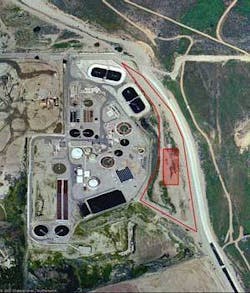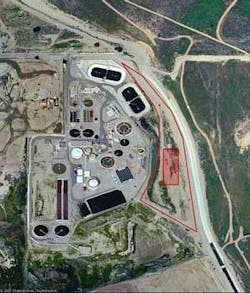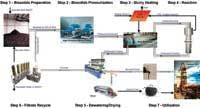Land application, landfilling, and incineration are the three primary options for managing the approximately seven million dry tons of biosolids produced each year in the United States, with the majority of biosolids recycled via land application. However, the environmental impact of traditional biosolids management techniques are being questioned and agencies are seeking environmentally sound biosolids recycling and beneficial reuse technologies.
EnerTech Environmental’s patented SlurryCarbTM process offers a new approach for treating and recycling biosolids that takes advantage of the organic content to produce a renewable fuel. This beneficial reuse option requires approximately two-thirds less energy than a conventional dryer, destroys pathogens and organic pollutants, and produces a renewable fuel with an energy content of approximately 7,000 Btu/lb.
EnerTech’s process chemically converts biosolids into a fuel that can be used in most coal-burning facilities. Using heat and pressure, the process carbonizes the organic matter in biosolids and ruptures cell walls to release bound water. The resulting slurry dewaters to 50% total solids by centrifugation, and is then dried using approximately two-thirds less energy than conventional drying. The energy savings result in approximately a one-third reduction in overall cost compared to traditional drying technologies.
The SlurryCarbTM process consists of seven basic steps, described below:
Step 1 - Biosolids Preparation
Biosolids at 20-30% by weight solids are received from various wastewater treatment plants. The feedstock is then macerated until all particles are less than ½ inch in diameter.
Step 2 - Slurry Pressurization
The prepared biosolids are slurried and pressurized above the vapor pressure of water at the desired reaction temperature. Pressurization prevents the water from boiling during reaction and ensures that the carbonization reactions occur in liquid phase.
Step 3 - Slurry Heating
Specially designed heat exchangers raise the temperature of the slurry to the range of 400-550oF.
Step 4 - Reaction
The cellular structure of the biosolids ruptures (lysis) and the carboxyl groups (-C-O-O) of the organic molecules break off and are released as carbon dioxide gas in a reaction known as decarboxylation. This reaction causes the biosolids to become hydrophobic. The reaction is stopped short of pyrolysis.
Step 5 - Dewatering/Drying
After partial cooling and depressurization, the carbonized slurry is dewatered via centrifugation to about 50% by weight total solids. The dewatered slurry is then dried to 90+% total solids. This final product, called E-Fuel, is a renewable fuel with a heating value of approximately 7,000 Btu/lb.
Step 6 - Filtrate Processing and Recycle
The centrifuge centrate and dryer condensate are further processed to remove contaminants in a wastewater treatment step. The resulting effluent is discharged with a portion being recycled back to points in the process where it can be used.
Step 7 - Utilization
The renewable E-Fuel is used as an alternative to fossil fuels. E-Fuel can be used in most coal-burning facilities with little or no modification to the facility’s existing equipment.
E-Fuel
The end product of the SlurryCarbTM process, E-Fuel has been certified as a renewable fuel by the California Energy Commission and the Green-e Renewable Electricity Certification Program and can be used as a renewable alternative to fossil fuels.
With a heating value of approximately 7,000 Btu/lb and combustion characteristics similar to lignite coal, E-Fuel can help reduce the overall use of fossil fuels and help states meet their renewable energy goals. It can be used in cement kilns, oil boilers, gasifiers, fluidized beds and most other coal-burning facilities.
It is an ideal feedstock for cement kilns in particular. The relatively high ash content of the E-fuel can be incorporated directly into the cement product, reducing the quantity of cement feedstock required. When used in a cement kiln, there is no residual at the end of the process. Complete biosolids recycling is achieved.
Case Study
EnerTech and its engineering partner HDR have designed a 675 wet tons per day SlurryCarb facility in Rialto, CA. The facility is being constructed adjacent to the City of Rialto wastewater treatment plant.
The Rialto facility has received strong support from local municipalities seeking long-term, environmentally sound biosolids recycling and beneficial reuse options to replace diminishing land application options. Once operational, it will receive and process biosolids from five area municipalities, providing permanent, complete biosolids recycling and avoiding the environmental concerns associated with agricultural land application. Because of these concerns, the project is on a fast track, using the design-build delivery method. Construction is underway and operations are scheduled to commence in early 2008.
The Rialto facility will produce approximately 140 tons per day of E-Fuel which will be used as a renewable fuel in lieu of coal in a local cement kiln. This beneficial use will allow the cement kiln to reduce ore consumption and lower emissions of fossil-fuel based greenhouse gasses.
Conclusion
As biosolids volumes continue to rise and the future of traditional biosolids management techniques becomes more uncertain, agencies are seeking environmentally sound biosolids recycling and beneficial reuse technologies. The Rialto facility and its patented SlurryCarbTM process offer a new biosolids management option to biosolids managers seeking a sustainable, environmentally sound approach to recycling biosolids and generating renewable energy.
About the Author:
Brian Dooley is the manager of marketing and special projects for Enertech Environmental, Inc. He can be reached at 404-355-3390 or [email protected].





